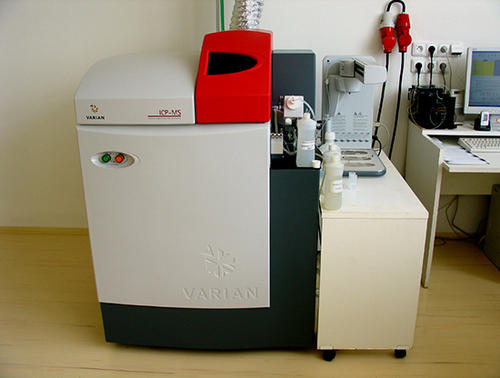ICP-MS laboratory
ICP-MS (Inductively Coupled Plasma Mass Spectrometry) or plasma source mass spectrometry is today the most versatile method for analyzing the concentrations of trace elements in geomaterials and in chemical and technical products.
ICP-MS (Inductively Coupled Plasma Mass Spectrometry) or plasma source mass spectrometry is today the most versatile method for analyzing the concentrations of trace elements in geomaterials and in chemical and technical products. The advantage of the method lies in the almost complete ionization of most elements, which is achieved using an Ar plasma with temperatures between 5000 and 7000°C, and in the rapid data acquisition.
The Thermo Electron Element The device has three different resolution levels, which are achieved by varying the width of the entrance slit. This option allows isobaric overlays of peaks of almost identical mass to be identified at medium or high resolution. The ions are detected using a single collector system, usually with the secondary electron multiplier, which can be operated in either pulse counting or analogue mode. For even higher ion currents, a Faraday cage is available, which takes over the collection above a certain threshold value. This results, at least theoretically, in a detection range of up to 12 orders of magnitude (100 to 1012 counts per second, cps). However, there are currently problems with the calibration of the SEV-Faraday signal ratio that are preventing the use of the cup.
The sensitivity of Element XR is typically >106 cps for 1 ng/g of element In, and detection limits of many elements are in the pg/g to fg/g range. These parameters can be adjusted using different inlet systems, e.g. T. still improve. For example, with a desolvation system such as the Aridus, the sensitivity can be further increased and the probability of molecular overlays on mass peaks can be reduced.
The current focus of trace element analysis with Element XR is on ultratrace elements such as the platinum group elements (PGE), Re and Au for concentration determinations in earth's rocks and in meteorites. In addition, we have recently established the determination of concentrations of rare earth elements in ultramafic rocks. Further methods planned for the future: analysis of chalcophile and moderately siderophile elements in meteorites and planetary materials, trace element abundances (Mn, Ba, U etc.) in marine carbonates.
If you have any questions about ICP-MS methods and applications, please contact:
Dr. Philip Gleißner
Building B, Room B.221
030 838 70670
E-Mail: gleissner@zedat.fu-berlin.de
oder
Prof. Harry Becker
Haus B, Raum B230
Tel. 030 838 70668
E-Mail: hbecker@zedat.fu-berlin.de
Wir bieten 2x im Jahr ein 1-wöchiges Laborpraktikum zur Einführung in die Plasmaquellenmassenspektrometrie an (siehe FU-Vorlesungsverzeichnis, Infos: F. Wombacher). Diese LV ist für M.Sc.-, Diplom- und B.Sc.-Studenten mit Schwerpunkt Geochemie gedacht. Unabhängig davon sollte jeder, der dieses Gerät benutzen möchte dieses Praktikum absolviert haben.
